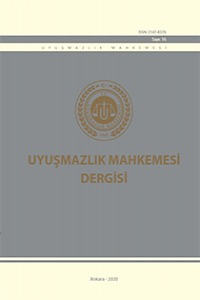Suçluların İadesinde Uygulanabilir Kurallar ve Uluslararası Adli Yardım, Bosna Hersek’te Uluslararası Adli Yardim Kaynaklarının Hiyerarşi Sorunları
Makale, uluslararası yargısal işbirliği konusunda iç hukuk kuralları ve uluslararası anlaşmalar arasında çatışma olması durumunda hangisinin uygulanma kabiliyeti olduğuna değinmektedir. İç hukuk, tamamlayıcı olup uluslararası sözleşmelerin hükümlerinin yorumlanması ve tamamlanmasında uluslararası hukuki işbirliğinin düzenleyicisi olarak yeri doldurulamaz bir rol oynamaktadır. Uluslararası hukuk sisteminde, anlaşmaların hiyerarşisi (çok taraflı sözleşmeler, ikili anlaşmalar) tanınmakta ve kabul edilmektedir. Bunların hiyerarşileri yasal hükümler (şekli hiyerarşi) tarafından belirlenir veya bazı uygun seçimler (esas ilişkin hiyerarşi) sonucunda ortaya çıkabilir.
Anahtar Kelimeler:
Hiyerarşi, uluslararası anlaşma, antlaşmalar, sözleşmeler
APPLICABLE RULES ON EXTRADITION AND INTERNATIONAL LEGAL ASSISTANCE, Problems of their Hierarchy in Bosnia and Herzegovina
The article deals with the legal force of domestic law and international agreements on international judicial cooperation in cases of conflict between them. Domestic law is subsidiary; nevertheless, it plays an irreplaceable role as a regulator of international judicial cooperation in support of international agreements by interpreting and complementing their provisions. In the international law system, hierarchy of the agreements (multilateral conventions, bilateral treaties) is recognized and accepted. Their hierarchy is established by statutory provisions (formal hierarchy) or may come as a result of some appropriate choice (factual hierarchy). The present article focuses on problems pertaining to international judicial cooperation in criminal matters. However, its findings and conclusions are applicable accordingly to international judicial cooperation in civil and other legal matters as well.
Keywords:
hierarchy, international agreement, treaties, conventions,
___
- AKEHURST Michael, The Hierarchy of the Sources of International Law, in “British Yearbook of International Law”, Vol. 47.1, 1975, p. 273.
- BERMAN M. N, Lesser Evils and Justification: A Less Close Look. Law and Philosophy, Vol. 24, p. 681, 2005; Univ of Texas Law, Public Law Research Paper No. 84.
- BROWNLIE Ian. Principles of Public International Law (7th edn), Oxford, 2008, p.45.
- Compilation of replies to the questionnaire on the reference moment to be applied when considering double criminality as regards extradition requests, EUROPEAN COMMITTEE ON CRIME PROBLEMS, COMMITTEE OF EXPERTS ON THE OPERATION OF EUROPEAN CONVENTIONS ON CO-OPERATION IN CRIMINAL MATTERS, Council of Europe, Strasbourg, 5 March 2014 [PC-OC/Docs 2013/ PC-OC (2013)12Bil rev3].
- Draft note on dual criminality, in concreto or in abstracto, EUROPEAN COMMITTEE ON CRIME PROBLEMS, COMMITTEE OF EXPERTS ON THE OPERATION OF EUROPEAN CONVENTIONS ON CO-OPERATION IN CRIMINAL MATTERS, Council of Europe, Strasbourg, 25 January 2012 [PC-OC/Documents 2012/ PC-OC(2012) 02 ], p. 2-3.
- GUIDANCE NOTE ON EXTRADITION AND INTERNATIONAL REFUGEE PROTECTION. UNHCR, Protection Policy and Legal Advice Section, Division of International Protection Services, Geneva, 04.2008, p. 6.
- Information received from states on practical problems encountered and good practice as regards the interaction between extradition and asylum procedures, EUROPEAN COMMITTEE ON CRIME PROBLEMS, COMMITTEE OF EXPERTS ON THE OPERATION OF EUROPEAN CONVENTIONS ON CO-OPERATION IN CRIMINAL MATTERS, Council of Europe, Strasbourg, 5 March 2014 [PC-OC/PC-OCMod/2013/Docs PC-OC Mod 2013/ PC-OC Mod(2013) 06rev2],
- GIRGINOV A, Outgoing Requests by Bosnia and Herzegovina for International Judicial Cooperation in Criminal Matters, Sarajevo, 2016, p 23.
- Eser A. Justification and Excuse", in American Journal of Comparative Law, 1976, No. 24, p. 629.
- KOSKENNIEMI Martti, Hierarchy in International Law: A Sketch, in European Journal of International Law, Vol. 8, 1977, p. 566.
- SARI Ismail, “The nexus between terrorism and Organized Crime: Growing Threat?”, in Uyuşmazlik Mahkemesi Dergisi - Turkey, Ankara, 2015, No. 6, p. 463.
- SHELTON Dinah, “Normative Hierarchy in International Law”, in The American Journal of International Law, Vol.100.2, 2006, p. 291.
- ISSN: 2147-8376
- Başlangıç: 2012
- Yayıncı: T.C. UYUŞMAZLIK MAHKEMESİ
Sayıdaki Diğer Makaleler
BEDEN MUAYENESİ VE VÜCUTTAN ÖRNEK ALMA
TALEPLE BAĞLILIK İLKESİ BAKIMINDAN YARGITAY’IN BİR KARARININ İNCELENMESİ
YARGITAY’IN TÜRK CEZA KANUNU’NDA YER ALAN DEĞER AZLIĞI KAVRAMINA YÖNELİK YAKLAŞIMI
Caner GÜRÜHAN, Tahir Hami TOPAÇ, Ahmet Serhat Ergin KANAT
SİYASİ SORUMLULUK KURUMUNUN HÜKÜMET SİSTEMLERİ AÇISINDAN DEĞERLENDİRİLMESİ
İŞÇİ ALACAKLARI AÇISINDAN GELİR VERGİSİ VE YASAL KESİNTİLER
İDARİ YARGIDA GÖREV UYUŞMAZLIĞI
SORUŞTURMA YÖNTEMİ OLARAK DAİMİ ARAMA KARARLARI VE HUKUKİ NİTELİĞİ
